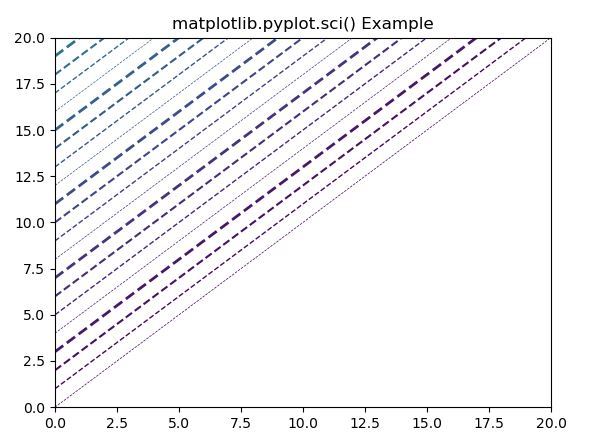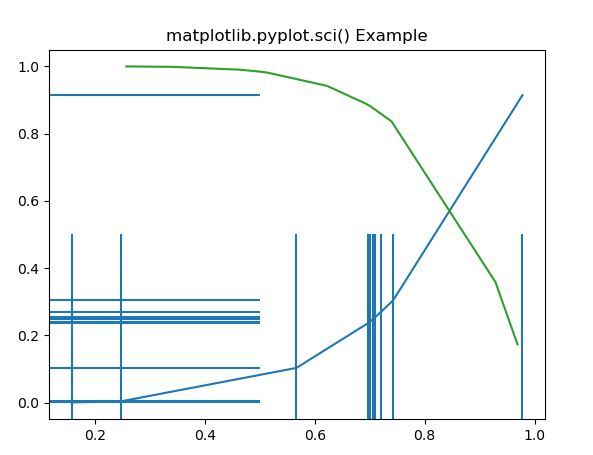Matplotlib是Python中的一个库,它是数字的-NumPy库的数学扩展。 Pyplot是Matplotlib模块的基于状态的接口,该模块提供了MATLAB-like接口。在Pyplot中可以使用各种图,例如线图,轮廓图,直方图,散点图,3D图等。
matplotlib.pyplot.sci()函数
matplotlib库的pyplot模块中的sci()函数用于设置当前图像。
用法: matplotlib.pyplot.sci(im)
参数:
- im:该图像将成为颜色图函数的目标。
返回值:此方法不返回任何值。
以下示例说明了matplotlib.pyplot中的matplotlib.pyplot.sci()函数:
范例1:
import matplotlib.pyplot as plt
from matplotlib.collections import LineCollection
from matplotlib import colors as mcolors
import numpy as np
N = 50
x = np.arange(N)
ys = [x + i for i in x]
fig, ax = plt.subplots()
ax.set_xlim(0, 20)
ax.set_ylim(0, 20)
line_segments = LineCollection([np.column_stack([x, y]) for y in ys],
linewidths =(0.5, 1, 1.5, 2),
linestyles ='dashed', color ="#eeffdd")
line_segments.set_array(1/(x + 1))
ax.add_collection(line_segments)
line_segments.set_array(x)
plt.sci(line_segments)
plt.title('matplotlib.pyplot.sci() Example')
plt.show()输出:

范例2:
import matplotlib.pyplot as plt
from matplotlib.collections import EventCollection
from matplotlib.collections import LineCollection
import numpy as np
np.random.seed(19680801)
xvalue = np.random.random([2, 10])
xvalue1 = xvalue[0,:]
xvalue2 = xvalue[1,:]
xvalue1.sort()
xvalue2.sort()
yvalue1 = xvalue1 ** 4
yvalue2 = 1 - xvalue2 ** 6
fig = plt.figure()
ax = fig.add_subplot(1, 1, 1)
ax.plot(xvalue1, yvalue1, color ='tab:blue')
ax.plot(xvalue2, yvalue2, color ='tab:green')
xresult1 = EventCollection(xvalue1, color ='tab:blue')
yresult1 = EventCollection(yvalue1, color ='tab:blue',
orientation ='vertical')
ax.add_collection(xresult1)
ax.add_collection(yresult1)
plt.sci(xresult1)
plt.title('matplotlib.pyplot.sci() Example')
plt.show()输出:

注:本文由纯净天空筛选整理自SHUBHAMSINGH10大神的英文原创作品 Matplotlib.pyplot.sci() in Python。非经特殊声明,原始代码版权归原作者所有,本译文未经允许或授权,请勿转载或复制。
